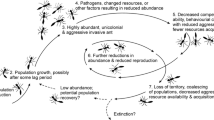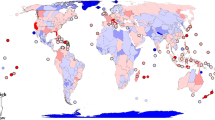Abstract
Invasive species are known to exhibit boom and bust cycles. We report population declines of one of the world’s most serious ant invaders, Anoplolepis gracilipes (Smith) (yellow crazy ant) in Arnhem Land, Australia. Anoplolepis gracilipes populations are known to fluctuate, both spatially and temporally, but this is the first instance of quantitative monitoring of spatial declines of entire populations. We present before and after survey data on seven populations that have either declined substantially or disappeared completely without human intervention. Sites ranged in size from 1.8 to 15 ha. Although the mechanistic cause of these declines remains unknown, A. gracilipes populations in Arnhem Land represent a unique opportunity to investigate mechanisms by which a globally significant invader declines, which could have important implications for invasive species management worldwide.




Similar content being viewed by others
References
Abbott K (2005) Supercolonies of the invasive yellow crazy ant, Anoplolepis gracilipes, on an oceanic island: forager activity patterns, density and biomass. Insectes Soc 52:266–273
Abbott K, Green P, O’Dowd D (2014) Seasonal shifts in macronutrient preferences in supercolonies of the invasive yellow crazy ant Anoplolepis gracilipes (Smith, 1857) (Hymenoptera: Formicidae) on Christmas Island, Indian Ocean. Aust Entomol 53(3):337–346
Cooling M, Hartley S, Sim D, Lester P (2012) The widespread collapse of an invasive species: Argentine ants (Linepithema humile) in New Zealand. Biol Lett 8(3):430–433
Espadaler X, Lebas C, Wagenknecht J, Tragust S (2011) Laboulbenia formicarum (Ascomycota, Laboulbeniales), an exotic parasitic fungus, on an exotic ant in France. Vie et Milieu 61(1):41–44
Gruber M, Burne A, Abbott K, Pierce R, Lester P (2012a) Population decline but increased distribution of an invasive ant genotype on a Pacific atoll. Biol Invasions 15(3):599–612
Gruber M, Hoffmann B, Ritchie P, Lester P (2012b) Genetic diversity is positively associated with fine-scale momentary abundance of an invasive ant. Ecol Evol 2(9):2091–2105
Gruber M, Friedlander A, Buckley K, Jack C, Hoffmann B, Ritchie P, Lester P (in press) Among-population diversity in microbial communities of the invasive yellow crazy ant Anoplolepis gracilipes. PLoS One
Haines I, Haines J, Cherrett J (1994) The impact and control of the Crazy ant, Anoplolepis longipes (Jerd.), in the Seychelles. In: Williams D (ed) Exotic ants: biology, impact, and control of introduced species. Westview Press, Boulder, pp 206–218
Hoffmann B (2014) Quantification of supercolonial traits in the yellow crazy ant, Anoplolepis gracilipes. J Insect Sci 15:25
Hoffmann B (2015) Integrating biology into invasive species management is a key principle for eradication success: the case of yellow crazy ant Anoplolepis gracilipes in northern Australia. Bull Entomol Res 105:141–151
Hoffmann B, Saul W (2010) Yellow crazy ant (Anoplolepis gracilipes) invasions within undisturbed mainland Australian habitats: no support for biotic resistance hypothesis. Biol Invasions 12:3093–3108
Holway D, Lach L, Suarez A, Tsutsui N, Case T (2002) The causes and consequences of ant invasions. Annu Rev Ecol Evol Syst 33:181–233
Lach L, Hoffmann B (2011) Are invasive ants better plant-defense mutualists? A comparison of foliage patrolling and herbivory in sites with invasive yellow crazy ants and native weaver ants. Oikos 120:9–16
Majer J (1984) Recolonisation by ants in rehabilitated open-cut mines in Northern Australia. Reclam Reveg Res 2:279–298
O’Dowd D, Green P, Lake P (2003) Invasional “meltdown” on an oceanic island. Ecol Lett 6:812–817
Oi D, Valles S (2009) Fire ant control with entomopathogens in the USA. In: Hajek T, Glare T, O’Callaghan M (eds) Use of microbes for control and eradication of invasive arthropods, vol 6. Springer Netherlands, Dordrecht, pp 237–257
Russell-Smith J, Ryan PG, DuRieu R (1997) A LANDSATT MSS-derived fie history of Kakadu National Park, monsoonal northern Australia, 1980–1994: seasonal extent, frequency and patchiness. J Appl Ecol 35:829–846
Sandström A, Anderson M, Asp A, Bohman P, Edsman L, Engdahl F, Nyström P, Stenberg M, Hertonsson L, Vrålstad T, Granèli W (2014) Population collapses in introduced non-indigenous crayfish. Biol Invasions 16:1961–1977
Simberloff D, Gibbons L (2004) Now you see them, now you don’t!—population crashes of established introduced species. Biol Invasions 6:161–172
Taylor C, Hastings A (2005) Allee effects in biological invasions. Ecol Lett 8:895–908
Valles S, Oi D, Yu F, Tan X, Buss E (2012) Metatranscriptomics and pyrosequencing facilitate discovery of potential viral natural enemies of the invasive Caribbean crazy ant, Nylanderia pubens. PloS one 7(2):e31828
Vogel V, Pederson J, Giraud T, Krieger M, Keller L (2010) The worldwide expansion of the Argentine ant. Divers Distrib 16:170–186
Wetterer JK (2006) The vanished plague ants (Hymenoptera: Formicidae) of 19th century Bermuda. Myrmecol Nachr 8:219–224
Wetterer JK (2012) Worldwide spread of the African big-headed ant, Pheidole megacephala (Hymenoptera: Formicidae). Myrmecol News 17:51–62
Young G, Bellis G, Brown G (2001) The crazy ant, Anoplolepis gracilipes (Smith) (Hymenoptera: Formicidae) in east Arnhem Land, Australia. Aust Entomol 28(3):97–104
Acknowledgments
We thank the many people that provided technical assistance, especially Daryl Lacey, Jon Edgar, Balupalu Yunupingu, Arian Pearson, Tony Schultz and the many people involved with Conservation Volunteers Australia. Thanks to Dhimurru Aboriginal Corporation and the traditional landowners of northeast Arnhem Land for access to the region, and the staff of Rio Tinto for access to the mining leases and accommodation. We thank Pete Green and an anonymous reviewer for their valuable comments.
Author information
Authors and Affiliations
Corresponding author
Rights and permissions
About this article
Cite this article
Cooling, M., Hoffmann, B.D. Here today, gone tomorrow: declines and local extinctions of invasive ant populations in the absence of intervention. Biol Invasions 17, 3351–3357 (2015). https://doi.org/10.1007/s10530-015-0963-7
Received:
Accepted:
Published:
Issue Date:
DOI: https://doi.org/10.1007/s10530-015-0963-7




